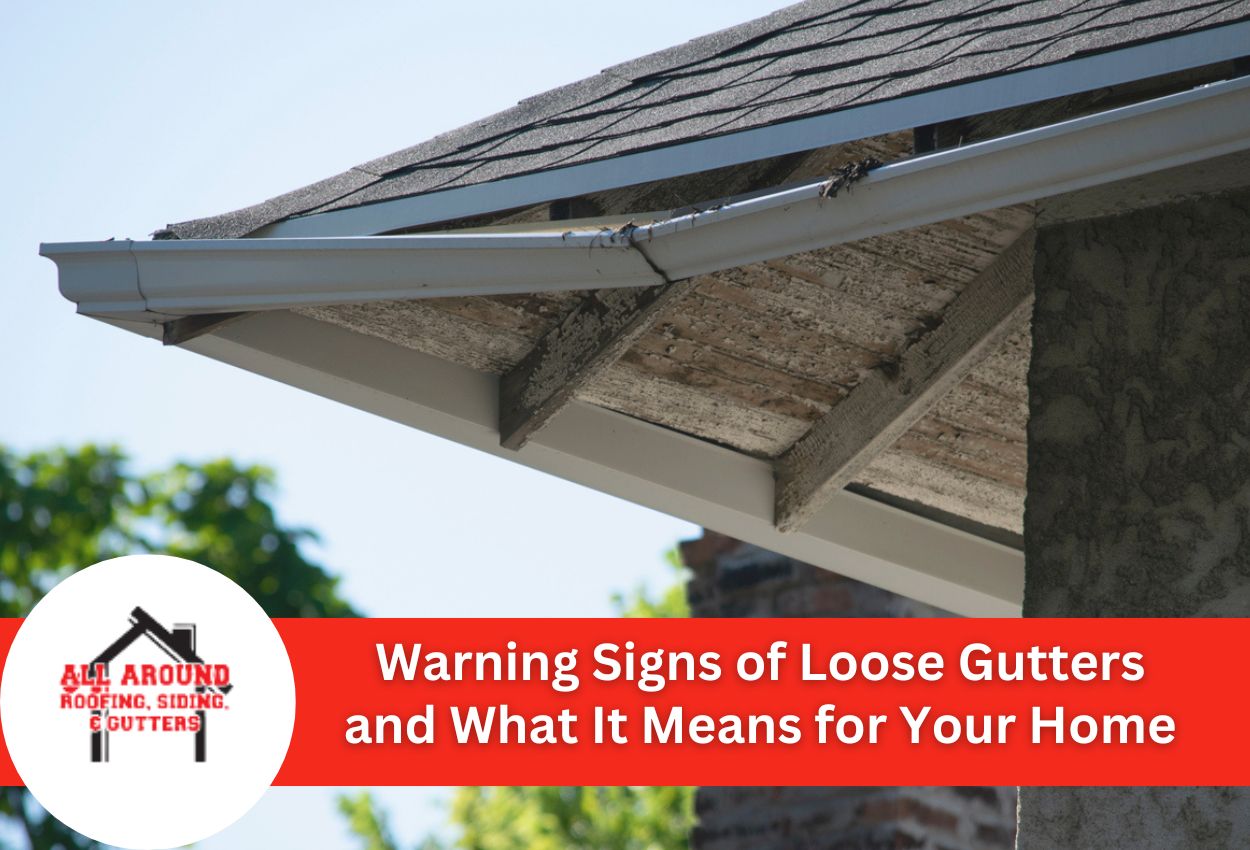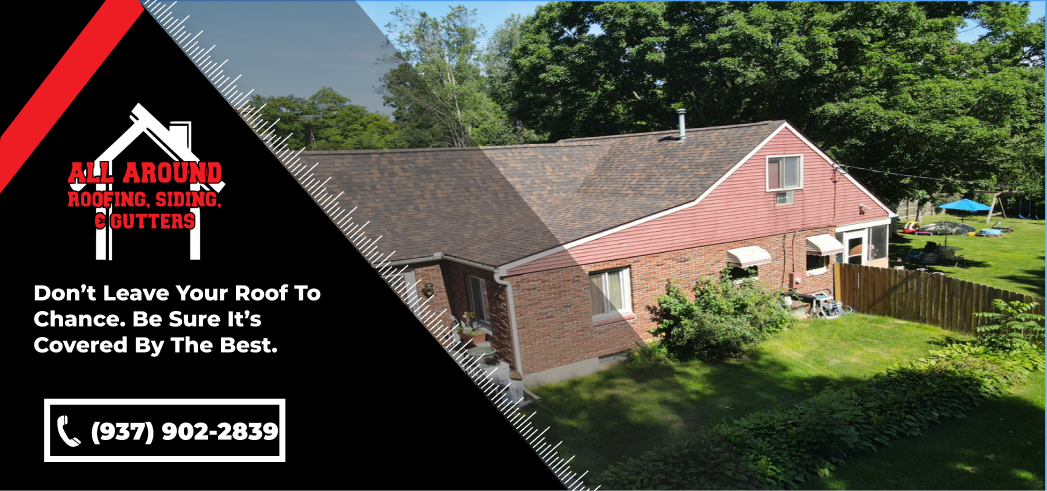Properly functioning gutters play a critical role in preserving your home’s exterior and preventing expensive water damage throughout your property. But loose gutters can create a domino effect of problems that can damage your home’s foundation, siding, and landscaping.
Most homeowners overlook subtle gutter repair warning signs until water damage becomes visible inside their homes. Damaged gutter symptoms develop gradually, making them easy to miss during casual observations. Knowing how to tell if gutters need replacing requires understanding what to look for during routine exterior inspections.
While they may be difficult to spot, sagging gutter indicators usually appear long before complete system failure occurs. Water pooling around your foundation, visible separation between sections, and gutters pulling away from the roofline signal that immediate attention is needed. These warning signs often develop after years of weather exposure, debris accumulation, and normal wear.
Recognizing the early signs of loose gutters prevents minor issues from becoming major headaches, protects your investment, and maintains your property’s structural integrity.
Sign #1. Visual Clues and Sagging
Spotting gaps between gutters and fascia boards is one of the most obvious signs of loose gutters requiring immediate attention. These spaces typically develop when mounting hardware loosens or fascia boards begin deteriorating from prolonged moisture exposure. Even small gaps allow water to seep behind the gutter system, potentially causing wood rot and structural damage to your roofline.
Homeowners should examine their gutters from ground level to identify sections that appear tilted outward or hanging at unusual angles compared to the roofline. This tilting motion occurs when brackets fail or mounting screws work loose from repeated expansion and contraction cycles. Gutters displaying these symptoms often worsen rapidly during heavy rain or snow.
A professional inspection is necessary when multiple sections show separation from the house or when gutters appear visibly detached at connection points. These gutter repair warning signs indicate that the mounting system is compromised and cannot support the weight of the water flow. Sagging gutter indicators, like visible bowing or drooping sections combined with separation gaps, suggest that immediate intervention may be able to prevent complete system failure.
Regular exterior observations help property owners determine if gutters need replacing before extensive damage occurs. Addressing visible separation quickly maintains water drainage and protects your home’s foundation and exterior surfaces from damage.
Sign #2. Water Flow Problems
Water spilling over the sides of gutters during light rainfall indicates that gutter sections have shifted out of position. When gutters pull away from their mounting brackets or develop improper slope angles, they cannot channel water effectively toward downspouts. This misalignment creates overflow situations even during moderate precipitation, suggesting that gutter damage is present and requires a professional evaluation.
Pooling water in specific gutter sections reveals where the system has pulled away from its supports and begun to sag. These low spots develop when mounting hardware fails or brackets become loose, creating uneven surfaces that trap standing water instead of promoting proper drainage flow. Damaged gutter symptoms like persistent pooling indicate structural weakness in the attachment system that allows sections to droop under normal water volumes.
Homeowners observing water cascading over gutter edges should examine those areas for visible separation from the roofline or fascia boards. These sagging gutter indicators often worsen progressively as additional water weight stresses already compromised mounting points. Understanding how to tell if gutters need replacing includes recognizing that consistent overflow problems typically signal attachment failure rather than simple blockages.
Effective gutter maintenance includes monitoring water flow patterns during rainfall to identify problem areas before complete detachment occurs. Addressing attachment issues promptly prevents the cascading damage that results when gutters fail to direct water away from your home’s foundation and exterior surfaces.
Sign #3. Sounds and Movement Related to Loose Gutter Systems
Rattling, banging, and scraping noises during storms provide clear audio evidence that gutters have loosened from their mounting systems. These sounds occur when gutter sections move independently from the house, creating metal-on-metal contact or allowing components to strike against siding or fascia boards. Storm-related noises typically intensify as weather conditions worsen, indicating that mounting hardware has failed to maintain secure attachment points.
Homeowners hearing persistent scraping sounds should investigate immediately, as these noises often signal that gutters are dragging against roofing materials or exterior walls. This movement damages both the gutter system and the surrounding surfaces while indicating serious structural attachment problems. Damaged gutter symptoms include grinding or squeaking sounds that develop when loose sections shift during normal wind rather than severe weather.
Gutters that sway or bounce visibly during moderate winds demonstrate compromised stability that requires professional attention. This movement indicates that mounting brackets have failed or loosened sufficiently to allow the entire system to shift independently from the house structure. Sagging combined with visible movement suggests that complete detachment may occur during the next significant storm.
Recognizing these gutter repair warning signs prevents sudden system failure that can cause extensive property damage. Understanding if gutters need replacing includes monitoring both audible and visual movement patterns that indicate structural instability within the mounting system.
Sign #4. Damage to Your Home’s Exterior
Failing gutters create distinctive water damage patterns that appear on siding, trim, and foundation areas directly beneath compromised sections. When loose gutters allow water to cascade over their edges or through separated joints, this uncontrolled flow leaves visible stains, discoloration, and moisture damage on exterior surfaces. These damage patterns typically develop gradually, starting as minor discoloration before progressing to more serious structural issues affecting wood trim and siding materials.
Water streaming from loose gutter sections often creates vertical staining patterns on siding that extend from the roofline toward the foundation. This consistent water flow saturates exterior materials, leading to paint failure, wood rot, and potential mold growth behind siding panels. Foundation areas beneath failing gutters frequently show signs of water pooling, soil saturation, and concrete staining where excess water collects instead of being directed away from the structure.
Landscape erosion around your home’s perimeter also indicates that gutters are not controlling water flow effectively. Deep channels in soil, exposed plant roots, and washout areas near downspouts suggest that the drainage system has failed to distribute water properly. Basement moisture problems often correlate with exterior gutter issues, as water collecting near the foundation can seep through basement walls and create humidity problems throughout lower levels.
Recognizing these exterior damage patterns helps property owners understand the connection between gutter performance and overall home protection, emphasizing the importance of maintaining properly functioning drainage systems.
Addressing the Damage: Simple Repairs vs. Complete Gutter Replacement
When signs of loose gutters are spotted, homeowners must determine if repairs can address the problem or if complete system replacement is the better option. Minor sagging issues and loose mounting brackets often qualify for straightforward repairs when caught early, before extensive damage compromises the entire system. Homeowners can address simple problems like tightening loose screws, reattaching separated brackets, or adding additional support hardware to sections showing slight drooping. These repairs work effectively when the underlying fascia boards remain structurally sound and only individual components have loosened from normal weathering.
Several clear indicators signal that gutter systems have deteriorated beyond simple repair solutions and require complete replacement. Extensive rust, multiple separated joints, severely rotted fascia boards, or gutters pulling completely away from the house structure indicate comprehensive system failure. Plus, when more than 30% of gutter sections show significant sagging or separation, replacement typically proves more cost-effective than attempting multiple individual repairs.
A professional evaluation helps determine whether the gutter damage is isolated or if system replacement is needed. Gutters showing widespread corrosion, multiple bracket failures, or consistent overflow problems despite recent repairs often need the complete installation of new components. Age is another critical factor when determining if gutters need replacing, as systems approaching 20 years typically lack the structural integrity for reliable repair solutions.
Understanding when repairs suffice versus replacement needs prevents homeowners from investing in temporary fixes that fail to address underlying structural problems affecting their property’s water management system.
Protecting Your Investment Through Regular Gutter Maintenance
Preventive maintenance programs help property owners identify signs of loose gutters before emergency repairs are needed. Establishing seasonal inspection routines allows homeowners to monitor gutter performance throughout different weather conditions, catching early warning signals that indicate developing problems. Regular maintenance can significantly extend a gutter system’s lifespan while reducing the likelihood of sudden failures that can cause extensive property damage.
Spring and fall inspections provide optimal timing for identifying gutter damage that develops during the harsher seasons. These routine checks should focus on examining mounting brackets, testing water flow patterns, and assessing overall system stability after winter freeze-thaw cycles and summer storms. Seasonal maintenance routines help establish baseline performance standards, making it easier to recognize when changes occur that signal potential attachment failures.
Professional maintenance services offer comprehensive system inspections that identify damaged gutter symptoms before they become visible to property owners. Experienced technicians understand how to tell if gutters need replacing by examining subtle structural changes that indicate developing problems. These services typically include cleaning, minor adjustments, and preventive repairs that address sagging gutter indicators before they progress to complete separation issues.
Implementing consistent gutter maintenance throughout the year protects your roofline while preventing water damage that affects foundation stability, exterior surfaces, and interior spaces. Regular attention to gutter performance maintains proper drainage function and preserves your property’s structural integrity for years to come.
Expert Gutter Repair Services in Your Area
If you’ve noticed any of the warning signs of loose gutters outlined in our article, such as gaps, sagging, or water spillover, it’s crucial to fix them as soon as possible to protect your home. Loose gutters can lead to serious damage to your property’s foundation, siding, and landscaping.
At All Around Roofing, Siding & Gutters, we specialize in identifying and fixing any gutter-related problems quickly and efficiently. Our team of experts is ready to restore the integrity of your gutter system, ensuring it performs well to protect your home from water damage.
Call us today at (937) 902-2839 for a thorough inspection and reliable gutter repair or replacement. Let us help you maintain a safe and dry home!


